|
Anybody who thinks the age of steam is over in China is welcome
to their opinion, but my experience in March of 2006 was again a
smorgasbord of steam.
True enough, it can no longer be enjoyed
Lazy
Susan style the way it was last year. Good steam locations are
getting fewer, and further apart, and more work and travel are
required all the time. However, it is still worth it to some of us.
Not only that, but it looks like it will be worth it for a few more
years yet. Like last year, this trip started in Beijing (if you
don't count flying from Denver), but all but one of the locations
visited were different. They will be presented in chronological
order, and observations will be mostly confined to the admittedly
narrow perspective of steam locomotives and taking pictures of them.
That is not to say that nothing interesting happened in between
photo shoots.....
 |
| One of the very last active members of class JF in the
enginehouse at the February 27th Wagon Works, near the now closed
Dahuichang narrow gauge on the edge of Beijing. |
March 16 --- Feb 27th Wagon Works in Beijing. Nobody has ever had a
kind word for this place, for good reason. Not only did they charge
us 200 Yuan per person to go inside and photograph their dead JF,
but they gave our guide a hard time, and limited our visit to 40
minutes. One of us was not allowed to take video, and another was
prohibited from smoking outdoors in the engine shed area. This last
even though there were two SYs working and a steam crane fired up,
and cutting torches in use.... oh yea, maybe the JF will be back in
service sometime in May. This is the least hospitable place I have
visited in China. While I insisted on coming here because I just had
to photograph their JF, I can probably live without a repeat visit,
and most people could probably live without coming here in the first
place. If you have a little time to kill in Beijing, the Dahuichang narrow gauge is still available for private steam
locomotive rentals. They are nice folks, and your business might
help to extend the life of these little engines.
 |
| Unusual dual headlight
SY 0732 is another of the Feb 27th Wagon Works
locomotive fleet. |
 |
| QJ killers. DF something diesels. I could
look up the model numbers and road numbers easily, but
who cares ?? Much as I hate to admit it, these things do
an excellent job, and the guys working on them are all
nice and clean instead of greasy, dirty, wet, and
slimy.
--- As luck would have it, this was the best picture I
got on one of the great steam lines remaining, the
Pingdingshan Coal Railway. Between the fog, the smog,
and what sunlight there was being from the wrong
direction, many visitors besides myself have had a hard
time getting decent pictures here. But, there's more to
life than train pictures.... |
March 17, 18, and morning of March 19 --- Pingdingshan. Mostly cloudy skies, but great action observed with five brightly painted QJ Killers, gobs of busy JSBs, two SYs, and poor old QJ 6450 working as the shop switcher. Crews were extremely nice, even though a driver was recently fired because he let a visitor run the engine. Cab rides were no problem, but please keep in mind that any employee on this or any other Chinese railroad needs his job worse than any of us need a souvenir or a chance to drive. Admission to restricted areas was 100 Yuan (about $12 USD) per visitor per day, and well worth it.
 |
| PDS is unique because it is the only place where all three
of the remaining standard China Rail steam classes still work
together. Badly beat up QJ 6450 with a four axle tender is the shop
switcher nowadays. Here she spots a JS with non-functioning air
brakes. |
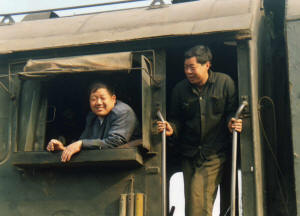 |
| Her crew are 30+ year veterans, and like almost every
railroader that I met in China, they are happy and proud of their
craft. Fortunately, QJ 6450 ran out of coal on the second day of my
stay, so we had to take a little cruise out to the nearest coal mine
and top off. Otherwise, I'd have only gotten to ride her for a few
meters. |
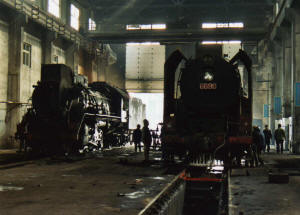 |
| Inside the adjacent running shop, are a JS getting a boiler
wash, and standby QJ 6690. |
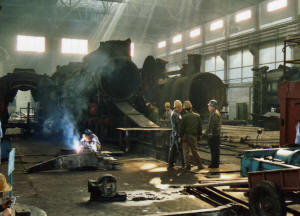 |
| The backshop holds two JSs getting new tubes, and a third
which is getting a complete overhaul. This is still a busy shop
during the week on day shift, despite recent photographs which
appeared to indicate otherwise. |
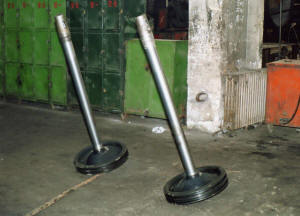 |
| Pistons fitted with new rods and rings are probably not
sitting in this spot anymore. |
 |
| Same for these freshly faced off driving boxes and pony
truck bearings. |
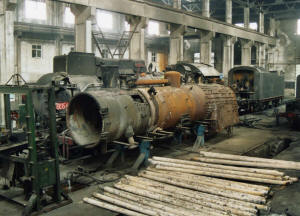 |
| It looks to me like they are planning to keep some steam
engines around for a few more years. |
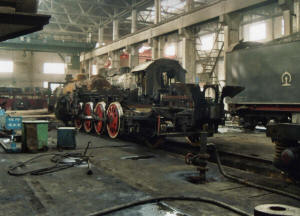 |
| For some time now, everybody has been
wondering if this will be the last engine to get the
whole enchilada. |
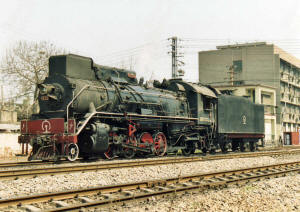 |
| Late model JS can be distinguished easily by the roller
bearing tender trucks and Laird crossheads. You know, I didn't quite
manage to get a picture of any of the dozen plus engines I saw
working when they were actually pulling a train, smokestack first in
decent light. The time of year with the clearest weather is the end
of February/beginning of March for this Henan Province area. |
 |
| Central Station in the town of Pingdingshan has passenger
workings going in both directions. JS 8030 waits to take one of the
3 times daily trains west to Baofeng, while east end power SY 1687
is just barely visible in the distance sitting clear of the main
line.
|
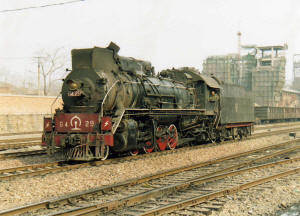 |
| Earlier JS class have Alligator crossheads and friction
bearing Andrews tender trucks. Even though I don't have any dramatic
sunny action shots from PDS, It was well worth a visit, and is well
worth another someday if I can swing it. Everybody who goes there
loves it, and thinks the people there are first rate, too. |
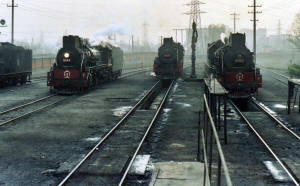 |
| I'll let this muddy overcast shot get by because it gives
you some idea of the shift change parade at the locomotive shop.
Estimates vary, but PDS has at least 16 active JSs, 2 active SYs,
and 2 active QJs. The two QJs I saw did very little, but there are
several recent reports that another QJ or two works the branch
running north to Yüzhou mine. These particular members of the
species are said to be genus deflectorless. Maybe if I'd been a
little smarter, I could have found out for myself.... |
 |
| Located near Pingdingshan in Henan Province is the adorable
Yinghao Coal Railway. The last train of the week coasts into the
junction of Xianyang with a string of empties on Sunday afternoon.
|
 |
|
Light engines are
stationed here to pull loads up the short, steep
branch from the mine at Liangwa. Sometimes these turns
doublehead, but not today. This must have been a sharp
looking little outfit when it was built in 1962.
Just IMAGINE the track repaired, raised, and leveled,
and all the bricks and broken tiles patched up in all
the buildings, and all the engines painted up
real pretty.... |
 |
| This is the little classification yard, and
one leg of a tiny little wye track built in a Rice field
behind the station building splits off from the main
line at lower right. |
March 19 --- Yinghao. One empty coal train and a few light engine movements were all we saw, but it was still fantastic. The workshops were busy with running repairs and one engine being built "brand new" from the best old parts of the many old C2s that could be found laying around. Most employees were making new mine supports and repairing mine machinery.
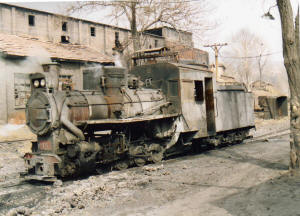 |
| Everything is crooked and catty-wumpus about this little line
nowadays, including 28 tons of rolling wreckage carrying #15.
|
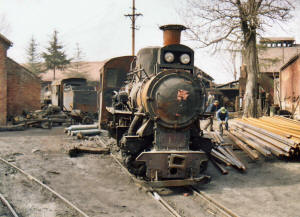 |
| This is the inside of the workshop compound at Huangmen, which
must have resembled the shops of the Salzkammergut Lokalbahn when it
was new!! This engine still runs, but she looks just like the
various nonfunctioning ones.... |
 |
| Even on Sunday afternoon, there was a pretty good crew working
on a "brand new engine made out of old pieces." |
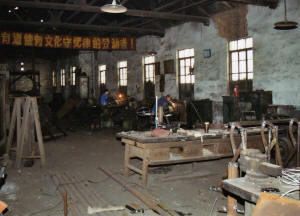 |
| The machine shop and welders were busy with locomotive repairs
and mine machinery as well.
|
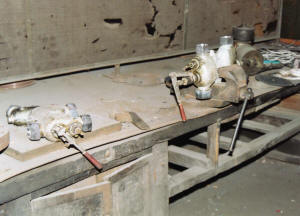 |
| Some new injectors went onto the brand new engine made out of
old parts.
|
 |
| So far as I know, the C2 0-8-0 is the only Chinese class to
have roller bearing rods.
|
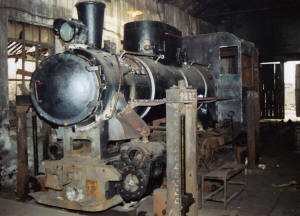 |
| Reports in
QJ country state that this engine is now working
as #04. |
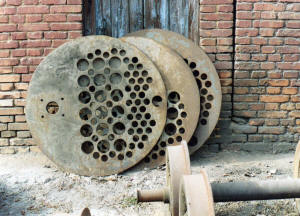 |
| Used tube sheets... maybe storm drain grates
of the future??
|
 |
| I just can't help thinking that I could get one of these in my
garage. |
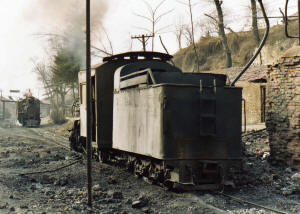 |
| Road engine #15 takes water while #13 shuffles back to the
shop.
|
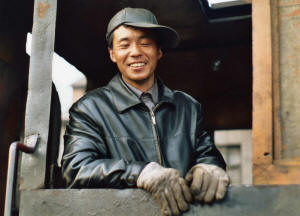 |
| This driver looks like he's glad he doesn't work in one of
those underground coal mines. The people here are as friendly as
they look.
|
 |
| Yinghao Coal Railway may be in a dirt poor area,
and about to close, and going broke, but it's charm is
undeniable. Somewhere in all that corrosion it says
engine #13.
|
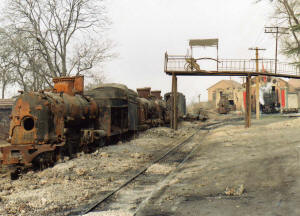 |
| Plenty more old parts available for construction of new
locomotives. The old sand tower still works adequately. |
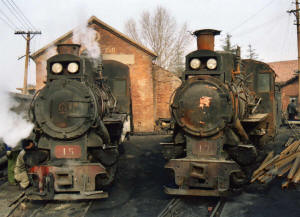 |
| For those who understand, no explanation is necessary. For
those who don't, none is possible....
|
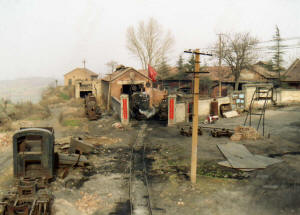 |
| Everything is here --- two engine houses, machine and welding
shops, material storage, basketball backboard, motorcycle parking,
and Chinese flag. |
March 20 --- Yinghao wasn't running trains Monday morning
because the mine wasn't working. Instead,
the coal was moving by truck, so we left there early and stopped at
Yima on our way to Xingyang. The small open pit mine was very abandoned, and the
workshops and yard looked pretty desolate. Water was dripping from
the standpipe, and one track had the rust rubbed off it, so I think
an engine was working somewhere nearby. We didn't waste time looking
for it because Xingyang was working, and what a beautiful little
line that is !! Of course, the trick is to get there on a sunny
day.... when the trains are running.
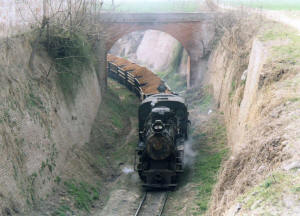 |
| The other narrow gauge treasure in Henan Province is the brick
works railroad located at Xingyang. The line is only a mile or two
long, but has the most beautiful scenery you could ask for. The
track twists and turns in every which direction so that a person
could take advantage of different light angles all day long. Of
course, I didn't get much light here, either, but the aqueduct which
supplies the Canola fields behind it would be in deep shadow on a
sunny day. |
 |
| This line is becoming famous for its arch bridge, spanning a
publicly accessible fishing hole. It is one place where you most
definitely do not need to pay any entrance fee or obtain special
permission for taking train pictures. They can only demand that if
you enter the brick factory itself. You can again spend all day here
shooting all angles from both sides of this bridge. Trains run every
hour or so, and you can climb the bluffs on the east side of the
lake if that appeals to you. Mostly I just watched the train, and
that was a very pleasant experience without fooling with my camera.
|
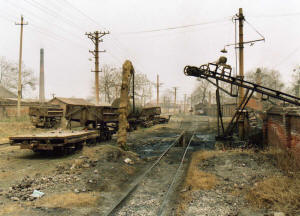 |
| This is their pit track and freight yard. Hard to tell it, but
this was a nice little piece of railroad once upon a time, with
concrete ties, signals, and some fancy brick retaining walls and
arches in the deep cut. I suppose it must be admitted that
appreciation of scenes like this is far from universal. |
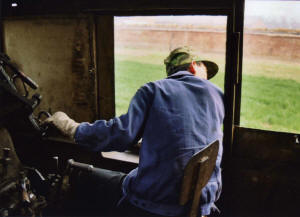 |
| This is pretty universal, though --- a seat
by the window with a whistle , throttle, reservoir, and brake handle all located within easy
reach. What I haven't figured out is why Chinese narrow gauge
engines drive on the right like ours, but the standard gauge power
drives on the left.... |
 |
| This is one of the unloading points on the city end of the
Xingyang line. The other end is a swampy clay pit, located on the
far side of the big bridge. Anybody who visits Pingdingshan should
try to visit here and Yinghao also. The weather should be favorable
(or not) for all three during the same season. |
March 21 --- We stayed in Xingyang until mid day. Without going into
all the details, we rode China Rail from Zhengzhou to Shenyang, and
had some time to kill before catching our next train to Mudanjiang.
This has to be at least a 1000 mile trip because Mudanjiang is clear
over by the Russian border, near Vladiovostock. Again, I hate to
admit it, but it's probably worth it to fly when you have these
great distances separating steam locations --- the extra expense is
offset by the fact that staying away from home costs money per diem,
anyway. That being said, China Rail runs a fine railroad, with
plenty of comfortable passenger trains, and it's a lot more fun that
flying. It also does my heart good to see so many people riding the
train.
March 22 --- I'm pleased to report that Sujiatun Steam Locomotive
Workshop is still working, but there are many less employees now,
and the place is deathly quiet compared to last year. Three SYs were
being repaired, and Fuxin SY 1012 had been finished and all dolled
up, and was locked inside the little shed. Access was no problem,
and the hostlers cheerfully ran the GJ tank engine a little bit for
us, even though they weren't going to use her until after we left.
Fuxin is reported closed now, with 20,000 people out of work in the
mines there. Again, the light was lousy, so I spent my time talking
to the hostlers and riding on the engine. For pictures taken at this
location last year in better times and with better light, please go
to the
first installment of
this article.
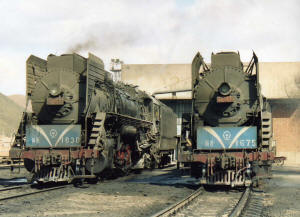 |
| Every time I travel somewhere for steam locomotive
photography, I have certain pictures I would like to get. This is
just about the only time in my life that one of these schemes has
worked out just as I planned. See above. Built in Datong in 1970 and
1974,
these two QJs at the Mudanjiang power plant were probably the oldest
remaining in service in 2006, and both featured high deflectors,
four axle tenders, and classy brass number plates. |
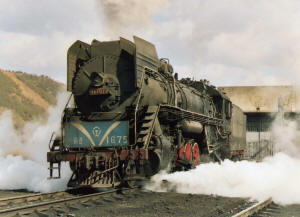 |
| Even when they're not doing anything, QJs make it look
impressive. Early in April, both of these majestic locomotives were
reported out of service. |
March 23 --- Mudanjiang. For 300 Yuan per visitor, we were allowed
to enter the premises of the power station and provided with an
official chaperone and company vehicle. Our visit was only supposed
to be for 40 minutes, but they relaxed that a bit, permitted cab
rides, and even took us back to the engine shed when the light
suddenly improved so that I could get a nice shot of their two very
early QJs side by side waiting for something to do. By the time
anybody sees this, the rented China Rail QJ killer is probably
already there, and they will have finished for good. Both QJs were
used during our visit, but mostly for one car moves. The cement
works also charged us 300 Yuan apiece to view their one live QJ. No
babysitter or vehicle was included, but cab rides were. There was
really nothing for the engine to do at the time we were there, but
the crew made a few moves over to the water crane and back to spot
just to be nice. The news here is that the QJs will not be replaced
with a diesel because the cement factory will be closed before too
long.
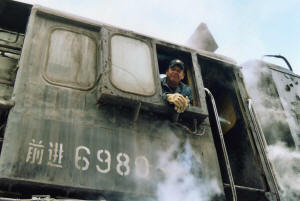 |
| In general, heavy industries in China do not let train
photographers inside the compound. Both the industries visited in
Mudanjiang charged a high entrance fee and offered very little
action. But, they were nice to us and they made sure that we were
taken care of, and only one of the two still had steam running by
the time I got home. I'll gladly do it again if I ever get the
chance, and if not, it's been good. |
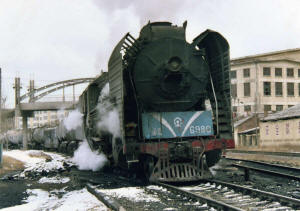 |
| Under all the dirt and grease and scuzz beats the heart of a
majestic QJ. |
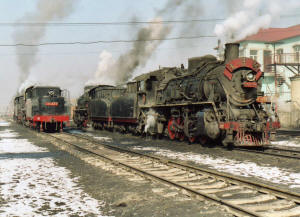 |
| Two of the four service tracks full of SYs starting day shift
at Chengzihe station, of the Jixi Coal Administration. |
March 24, 25, and morning of 26 --- JIXI. The city of Jixi is a few
hours drive from Mudanjiang, and is surrounded by coal mines and a
network of very businesslike industrial railroads which use SYs
exclusively. This place has it going on, yes it does. Stay here for
a week if you can. Plenty of track speed train miles, free access to
the right of way, some trains doubleheaded, a few with pushers, and
friendly crews on all parts of the system. This may change soon
because they are supposed to be setting up a permit system similar
to the one at Tiefa. Already some of the workshop leaders are
watching the crews closely, so don't be too eager to ride or drive
the engines. The guys are as nice to us as they can get away with.
This system is definitely worth paying to see, although we were too
cheap to cough up $50 each in American greenbacks just to visit the
workshops. Probably it will seem more attractive as more steam lines
close.... A real treat was the freshly overhauled SY 1437, decorated
splendidly for the Young Pioneers. In the China Rail compound, Iron
Bull QJ 6800 was off limits, and the guards told us that we needed
to get permission to visit her (I guess that should be HIM) from the
Harbin office of the China Rail Police. At least they are jealously
guarding him.
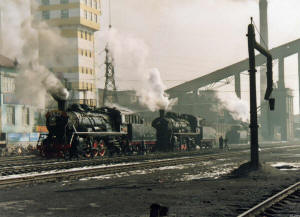 |
|
First in, last out. |
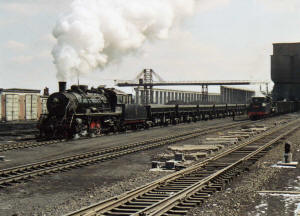 |
| Many Jixi engines have decorations, including these. SY 1351 and SY 1437 swap empties and loads at Xinghua mine on the Chengzihe system
|
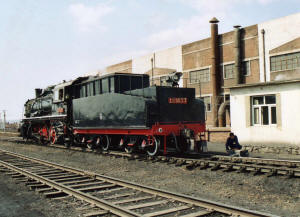 |
| Unfortunately, I didn't get to stay in any of these places
long enough to begin to figure out the scheme of operations and learn
my way around. After repeatedly giving out the advice to stay longer
in each location and visit fewer of them on a single journey, I
always do the opposite. At Zhengyang mine, the switch tender cranks a
power switch over by hand for sparkling SY 1437. |
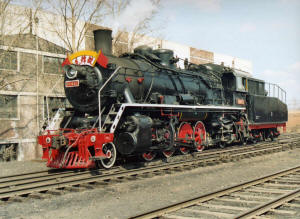 |
| Despite rumors to the contrary, Jixi looks like they plan to
use steam for a little while yet. Decorations honor the Young
Pioneers communist party youth group. |
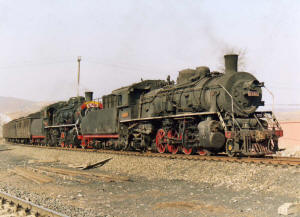 |
| At Qiaonan station in the afternoon, we caught SY 1437 on another
turn, this time with helper SY 0863. |
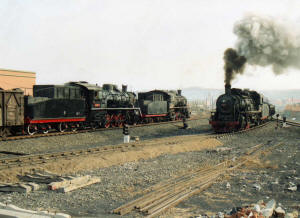 |
| Before the coal load can leave, a cut of empties has to clear
the plant. I should have tried some pictures inside the Qiaonan
operators office, showing the Desktop PC dispatching working
alongside ancient telephones, telegraphs, and signals. We had to
take our shoes off in there, but the guys again couldn't have been
nicer. |
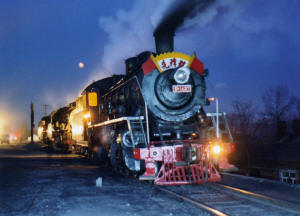 |
| Back at the Chengzihe service tracks, the engines have just
returned from day shift, and the night shift firemen are getting
their power ready. |
 |
| A little later, the driver grabs the gangway railing with his
grip slung over his shoulder, and takes charge of the locomotive. Then this place got real busy with lots of people carrying
lanterns and lights, and it started snowing, so I gave it up after
shooting half a roll. That's why they have bars in hotels. |
 |
| The next day we had bad weather until just before sunset.
Usually there are coal pickers with donkey carts at this coal washery, but it was too cold and windy for everybody except the one
poor lady in the background. |
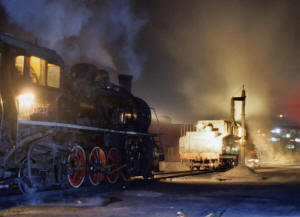 |
| The weather cleared up after dinner so
I decided to photograph the last part of shift
change instead of the beginning. There were only one or
two flood lights functioning in between the yard tracks.
It was so dark down there, that I thought that all of
the engines had already left. Finally I saw them after
getting within about half a car length from the first SY
out. It just so happens that I showed up right as SY
237's driver tried her headlight. |
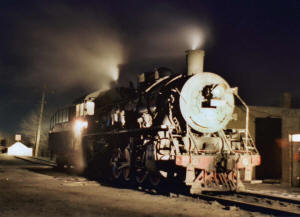 |
| Then, it was the guy in front of him trying his backup light.
Shortly after that, we tried the bar again....
|
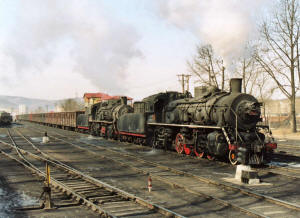 |
| This is the station and yard of the Hengshan system, which
has a half dozen or so engines based there. These empties are being
doubleheaded as a way of cutting down train movements for simpler
signaling, and for collision prevention purposes, rather than
because of tonnage. |
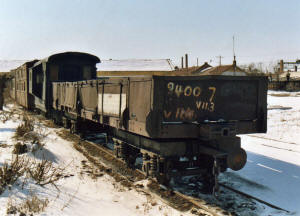 |
| Located a few hours drive from Jixi is the world renowned
Huanan Coal Railroad, a narrow gauge built as a logging line which now serves
the coal mines in a national forest area. |
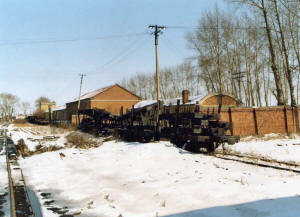 |
| This is said to be the best narrow gauge in China, and the
light was the best I had on my trip so far, but nothing was moving,
and nobody was around. |
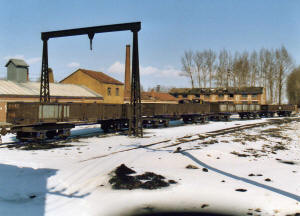 |
| Apparently, coal car bodies have been fitted with disconnect
trucks having drawbars linking them underneath the center
sills. |
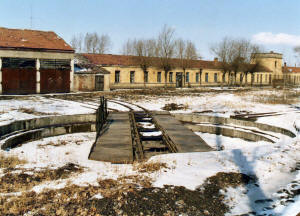 |
| This would be some picture with an engine
on the turntable,
wouldn't it ?? The ones locked in the shed were all fixed up and
painted nice, too, not rust buckets like some of my favorite lines
use... |
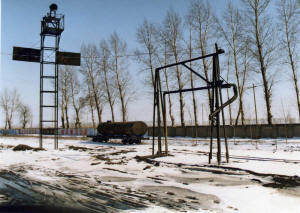 |
| I should have stayed in Jixi another day, but if I had, I'd
think I missed something for the rest of my life by not coming here.
You know they would have had an engine working.... |
March 26 --- Huanan was closed, all locked up, nobody around, so we
continued on to Hegang. This is another system like Tiefa and Jixi
which provides coal for the parent city's power plant. It is located
relatively close to Jixi and Huanan, so it is logical to visit these
three lines in succession.
 |
| Hegang has plenty of both steam and electric action, and
passenger trains, but of course the weather had turned sour on me
again. This turn connects the Fuli mine with Jipei station. |
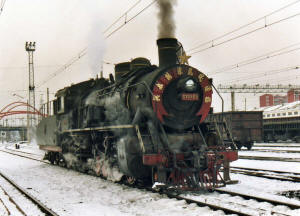 |
| A person could do very well by spending a little time on the
platform in Jipei station. It's a world class train watching spot,
unless you like diesels.
|
March 27 --- On the whole, Hegang was great, but it would be better
for pictures on a sunny day. Access was no problem, employees were
friendly, and there was plenty of serious action, both steam and
electric. No QJ killers here, or at Jixi, either. I'd love to try it
again someday. But after only a couple of hours, it was time for the
long haul to Harbin, and then up by the Russian border to
Zhalainouer. Not very good planning on my part.
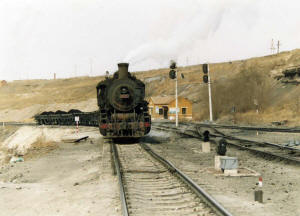 |
| Walking down the steps from the headquarters building to the
bottom of the open pit coal mine at Zhalainouer, this is the first
level with a lot of rail traffic. The little building is station
510, dispatching center for this operation, and waiting point for
the employee passenger trains which descend far below. |
 |
| This place gets pretty close to serving steam to you Lazy
Susan style, considering it's 2006. There are usually at least two
dozen engines all going at once within an area of 3 or 4 square
miles!!! |
March 28 and 29 --- ZHALAINOUER!!!!! I can't rave enough about this
place. To begin with, the access fee was a very nominal one time
charge of 100 Yuan for as long as you can stay. Everybody there,
management and employees alike, was as nice as they could be. The pit itself
looks to me like pictures of the Panama Canal construction project,
and I counted as many as 16 trains visible working at one time. No
QJ killers here, either, but maybe 40 SYs work the various systems,
and at least half a dozen steam cranes, including two that fill the
coaling stations. Again, the trick is to hit it on a sunny day, and
it sure helps if the ground is still frozen, too. Most trains are
wagons first or tender first, but there is so much going on that a
person can cherry pick what he wants to photograph. In fact, nobody
could cover it all, anyway. I was able to get repeated run bys of
engine first passenger, track laying, coal, and rock trains. The
track laying train had a steam crane and one of the work trains had
three air dumps and a caboose. The trick is to find the little blue
and red signs at the terrace levels which mark the workers paths up
and down the sides of the pit. While the train of your dreams is
sawing back and forth over the switchbacks, you can easily get ahead
of it as it descends or climbs the mine trackage. The workshops was
something else again, too, with two overhauls in progress, and a
busy running repair shed. The machine shop had at least thirty
employees running the usual complement of wheel lathes, turret
lathes, engine lathes, vertical and horizontal mills, boring mills,
radial arm drills, a couple of Bullards (Chinese version, of
course), etc. What was amazing is that every machine was going at
once, including three shapers. They say the coal is running out, so
this operation will close in a few more years. Don't miss it. You
can see it all in a day, but give it a week if you get the chance.
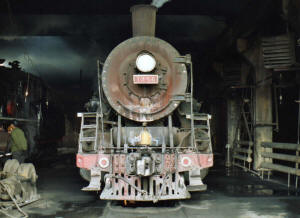 |
|
The light died on me just
about the time we made it to the mine, walked down a few
thousand steps, got our cameras out, and the first train
showed up, so we climbed back up the way we had come,
and went back over to the locomotive shop. |
 |
| The running shop was on one side of the machine shop, and had
three hot engines in it every time I checked.
|
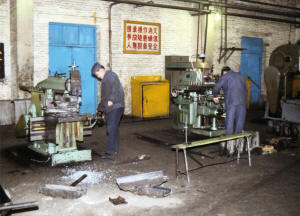 |
| Next door was the busiest steam locomotive repair shop I've
ever seen, ever. I couldn't get all the shapers inside a single
frame, but this gives you an idea.
|
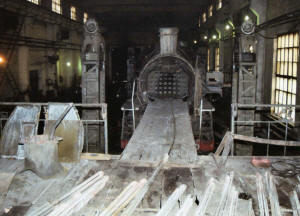 |
| This is the same arrangement they use at PDS for superheaters,
flues, and tubes. This engine was pretty much getting the full
treatment, only they hadn't taken the boiler off the frame. |
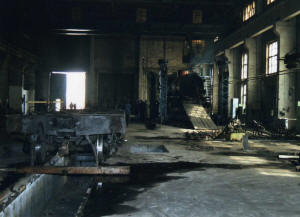 |
| In another separate hall entirely was a second SY
getting pretty much the full treatment. |
 |
| Nobody seems to be killing themselves. The old heads know that
just slows you down....
|
 |
| Probably there are more active steam engines in a smaller area
in Zhalainouer than anywhere else on earth. |
 |
| The sun came out that afternoon for an hour or so while we
visited Nanzhan service tracks. |
 |
| There were only three or four locomotives there at a time,
but the activity was constant.
|
 |
| Nowhere else on this trip did I see a steady stream of
engines taking coal and water, sand and grease, getting their rods
knocked and their fires cleaned, just like they used to the old
days. And the coaling tower was provisioned by a steam crane, from a
pit kept filled by cuts of air dumps brought up from the mine...
|
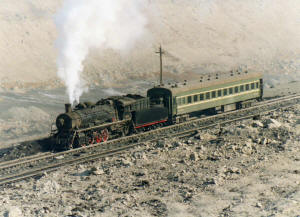 |
| All through this trip, I had been skunked every time I tried
to get a decent picture of a passenger train except for once at
Hegang. This view of the morning shuttle was taken on my last day
before returning home, as it returned from the bottom of the pit
after dropping off the workers. It was to be the best steam
passenger train chase of my life, ever. |
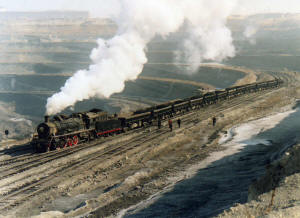 |
| Of course, I worked myself to death, running up and down and
all around the mine without learning my way around first. Probably I
could have stayed in one spot and gotten all these trains with less
effort. Lucky that my old, out of shape legs didn't give out !!
|
 |
| Less than a fourth of the open cast operation shows in my
pictures. I never made it to the bottom of the pit or to the south
end switchbacks and ladder tracks. There are also several connecting
lines which serve underground mines, and which would be fun to
explore, and the yards where the coal railroads interchange with
China Rail.
|
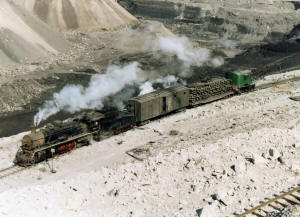 |
| At any one time there were several construction trains with
steam cranes constantly modifying and maintaining the complicated
web of tracks.
|
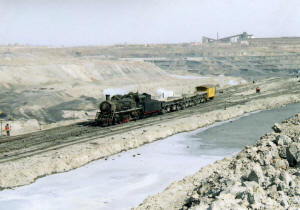 |
| Getting around was relatively easy because the ground was
still frozen, but it was dry and pretty much clear of snowdrifts.
They tell me this place gets awful cold in the middle of winter.
Sounds believable. Glad I missed it.
|
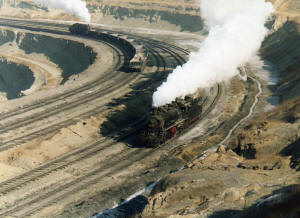 |
| The variety of available photo angles is great, even if the
landscape mostly has a lunar look to it. Tracks face every possible
direction, allowing favorable light angles at any time of day
somewhere in the open pit.
|
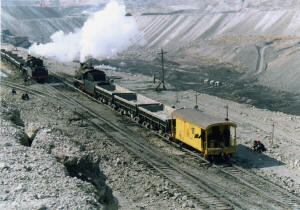 |
| Working from the terraces, only trains on the first level or
two below me would be visible. |
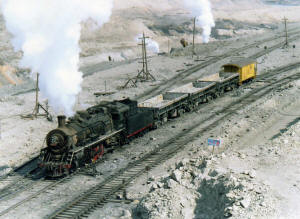 |
| Power poles and signals are placed on stands like Christmas
trees, so they can be repositioned easily. Employees have a system
of trails and stairs cut into the vertical walls which allow them to
quickly move between locations on different levels. One of these is
in the foreground marked with the standard sign shown below. |
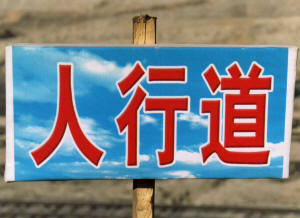 |
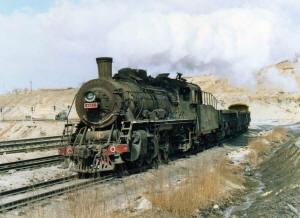 |
| Back up on station 510 level, this work train heads for
Nanzhan to tie up. |
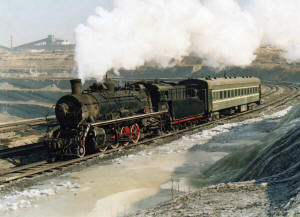 |
| Once again, if you want to believe that it's all over for
steam in China, go right ahead. I wouldn't care to trade places with
you.
|
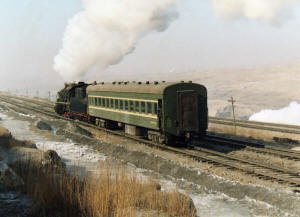 |
| There always has to be a last picture on any trip, and this
looks like it to me. Of course I'm indebted to all the railroad
employees of every location visited (except one) and China Rail for
a successful and enjoyable trip. Special credit must go to my
very excellent guide, Mr. Xuejun Liu. He has a
website featuring his
best photographs of Chinese steam locations presently active, and
with information on arranging visits to them. |
return to articles index |






















































































